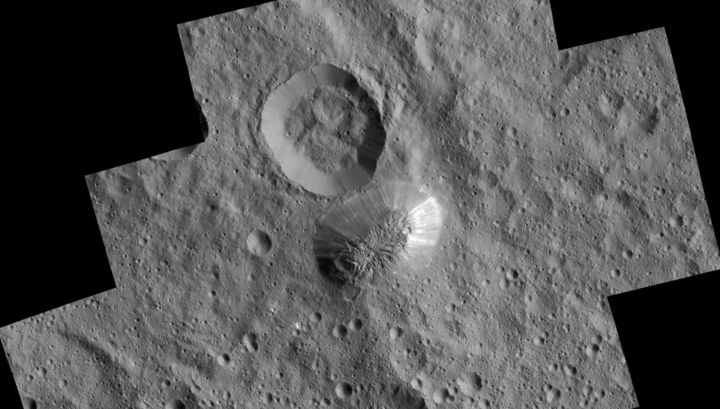The highest mountain on the dwarf planet Ceres – a freestanding Ahune Mons (Ahuna Mons). It towers above the surface about four kilometers from the base of a width of about 18 km. It would seem not so much by earthly standards, but the diameter of the Ceres is only a 950 km.
Moreover, according to new data published in the publication Science, Ahune Mons is nothing but how kriovulkan.
Since the spacecraft NASA Dawn ( “Dawn”) in March 2015 went into orbit around Ceres, information about the dwarf planet, in fact, as well as questions to it, it becomes more and more. Thus, according to one version, the mysterious white spots on the surface of the planet, which is also a change with time, may be the result of kriovulkanicheskoy activities. Fresh pictures Mountain Ahune Mons are proof of this.
According to the observations kriovulkany exist at very low temperatures only a few bodies of the solar system, such as a satellite of Neptune Triton, where they were first discovered. Scientists suspect that they also have the satellites of Saturn – Titan and Enceladus, and the satellites of Jupiter – Ganymede and Europe

Kriovulkany erupt not lava, but a mixture of salt water and ice, sometimes with an admixture of methane and ammonia. The surface of Ceres, with an average temperature of about -106? C is the best suited for their operation.
To understand how looks Ahune Mons, a team of researchers led by Ottaviano Ruche (Ottaviano Ruesch) used images and three-dimensional maps area received “Dawn.” They compared vyrisovalas contours and features of the object being studied with models of orogenic processes on Earth and on Mars.
It turned out that most Ahune Mons resembles a volcanic dome that formed when the crust does not explode under the pressure of the lava, and only It is breaking, letting out streams, which are then spread out over the slopes. Among the relevant characteristic signs scientists have noted the presence at the top of Mons Ahune cracks. tracks rockfalls.
In the press release NASA study authors note that one of the most important discoveries was that the active geological processes occurred at Ceres by the standards of space is relatively recent and view on the slopes. However, at the moment kriovulkan not work.

“We are confident that Ahune Mons formed during the last billion years and maybe it happened for hundreds of millions of years”, – says Ruche. This is a relatively young geological processes, given that the age of the solar system about 4.5 billion years old. The presence of the young volcano on Ceres surprising also because it – the world is small. . Such a body should quickly lose heat after its formation
“But Ahune Mons shows us that Ceres is still warm and rather more could recently rocks of volcanic activity”, – the scientist explains
So far, scientists are trying to figure out the next piece of information, “Dawn” continues its journey. Researchers dream that the new data will help to learn more about the life of “Lonely Mountain” Ceres and, of course, a secret they hope Ahune Mons ever wake up and show itself in all its glory, simultaneously opening the door into the bowels of the dwarf planet.
No comments:
Post a Comment